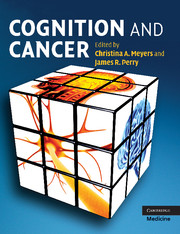Book contents
- Frontmatter
- Contents
- List of contributors
- Preface
- Section 1 Cognition and the brain: measurement, tools, and interpretation
- Section 2 Effects of cancer and cancer treatment on cognition
- 7 Biological bases of radiation injury to the brain
- 8 Cognitive dysfunction related to chemotherapy and biological response modifiers
- 9 Effect of hormones and hormonal treatment on cognition
- 10 Low-grade gliomas
- 11 High-grade gliomas
- 12 Brain metastases
- 13 Primary central nervous system lymphoma
- 14 Childhood brain tumors
- 15 Neurofibromatosis
- 16 Hematological malignancies
- 17 Paraneoplastic disorders
- 18 Symptomatic therapies and supportive care issues
- 19 Animal models and cancer-related symptoms
- Section 3 Interventions and implications for clinical trials
- Index
- Plate section
- References
18 - Symptomatic therapies and supportive care issues
Published online by Cambridge University Press: 13 August 2009
- Frontmatter
- Contents
- List of contributors
- Preface
- Section 1 Cognition and the brain: measurement, tools, and interpretation
- Section 2 Effects of cancer and cancer treatment on cognition
- 7 Biological bases of radiation injury to the brain
- 8 Cognitive dysfunction related to chemotherapy and biological response modifiers
- 9 Effect of hormones and hormonal treatment on cognition
- 10 Low-grade gliomas
- 11 High-grade gliomas
- 12 Brain metastases
- 13 Primary central nervous system lymphoma
- 14 Childhood brain tumors
- 15 Neurofibromatosis
- 16 Hematological malignancies
- 17 Paraneoplastic disorders
- 18 Symptomatic therapies and supportive care issues
- 19 Animal models and cancer-related symptoms
- Section 3 Interventions and implications for clinical trials
- Index
- Plate section
- References
Summary
Introduction
The supportive care of cancer patients routinely involves management of multiple symptoms as well as neuropsychiatric disorders associated with cognitive dysfunction, notably delirium, but also in some instances depression. Cancer therapies themselves (especially medications) can cause or exacerbate cognitive dysfunction. Cognitive disorders of all types are the second most common psychiatric disorders experienced by cancer patients after mood disorders (Derogatis et al., 1983). Patients in particular settings and stages of the disease continuum are at particular risk for cognitive impairment, with potential implications for prognosis. The boundaries between these disorders are not always distinct, which complicates accurate diagnosis and treatment. Co-morbidity is common. The stigma associated with mental illness and the physical burdens of caring for affected patients place family members and other caregivers at increased risk for physical and emotional distress. The common cognitive disorders seen in the oncology setting often respond well to treatment. In other cases, palliation of symptoms is possible and individual patients may respond to creative and unconventional medication interventions. Here we discuss common neuropsychiatric syndromes and clinical settings associated with cognitive dysfunction and altered mental status and behavior, interventions, and potential areas for future research.
Delirium
The American Psychiatric Association defines delirium as a syndrome characterized by rapid onset of impaired cognition, and altered consciousness, and it is presumed to be due to one or more physical or disease-related factors (Table 18.1, American Psychiatric Association, 2000; DSM-IV TR).
- Type
- Chapter
- Information
- Cognition and Cancer , pp. 258 - 269Publisher: Cambridge University PressPrint publication year: 2008



